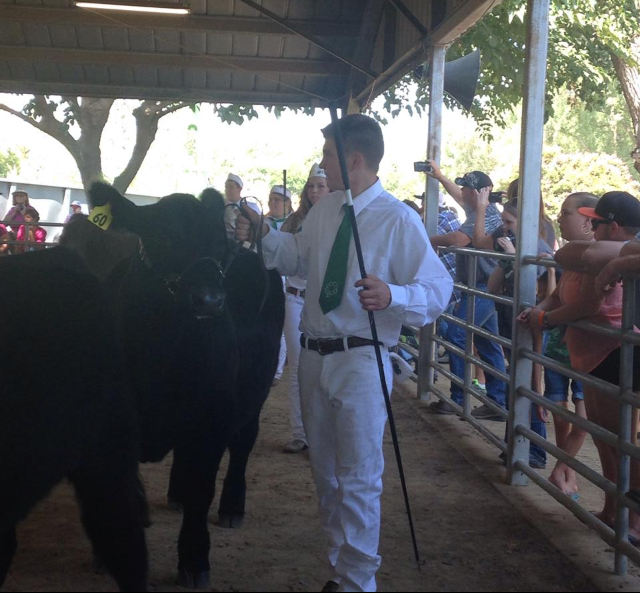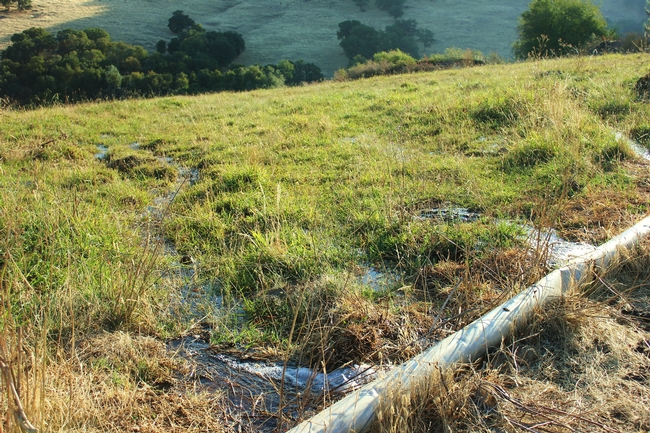- Author: Megan G Osbourn

Programs such as 4-H and FFA are excellent training platforms for youth who raise livestock on a small scale. In the last two weeks nearly 800 youth across three different counties exhibited livestock at either the Yuba-Sutter Fair or the Nevada County Fair. Exhibitors ranging from 9-19 years old, have been working tirelessly over the last year to prepare project animals such as cattle, sheep, goats, poultry and swine for competition and market. The process involves more than feeding and grooming animals on a daily basis, which in itself is not always an easy task.

Jake Williams (15) of the Smartsville 4-H Club, recently exhibited and sold his seventh steer at the Yuba-Sutter Fair. As a way to market his steer, Williams, like many other exhibitors, hand-delivers letters to businesses and community members who will potentially support the Junior Livestock Auction. Such tasks develop public speaking and communication skills, and remind young people to keep the primary goal in sight. “The most important part of raising a steer is creating a quality product for the buyer,” says Williams. “It's a lot of fun and I've learned a lot, but it is definitely hard work.”
Upcoming educational opportunity:

Youth and adults looking for additional resources, can visit the 4-H Youth Development Program for free curriculum and project sheets pertaining to animal and environmental sciences. Guides for livestock care can be found for several animal species through the UC Davis, Veterinary Medicine Extension program.
- Author: Ben Granholm

Nearly 60 individuals gathered at SFREC for the 6th Annual Lower Yuba River Accord Symposium on July 15th to dive into the history, management and future of the Lower Yuba River. Attendees listened to presentations and asked questions of those involved in the river's preservation.
Speaking on the goals of the River Management Team and the current Monitoring and Evaluation Program, Tom Johnson of the Yuba County Water Agency discussed efforts to develop optimum flow schedules, record temperature performance and ensure the smooth implementation of Yuba Accord operations.

Looking at the year-round temperatures of the Yuba River, Casey Campos and Duane Massa with the Pacific States Marine Fisheries Commission, talked of what these temperatures mean for the spawning and livelihood of fish inhabiting the river, particularly the habitats of the Chinook salmon. Campos explained that the Yuba River is among the coldest in the Central Valley.

Symposium coordinators, Gary Reedy of the South Yuba River Citizen League spoke on the need for habitat enhancement, giving a summary of previous actions, while Beth Campbell of the U.S. Fish & Wildlife Service (FWS) discussed enhancement initiatives implemented by FWS.
The symposium concluded with lunch at the Yuba River Education Center, followed by a float down the beautiful Yuba River.
- Contributors: Madison Easley, Larry Forero and Nikolai Schweitzer

For this project, researchers and staff regularly monitor and assess four factors associated with the production of foothill flood irrigated pasture utilizing pipe and ditch delivery methods. These factors include the amount of water applied to the pasture, the amount of water run-off, the effectiveness of irrigation, and the production of the pasture (measured in biomass and AUM harvest).

Preliminary findings indicate that the interval between irrigations could be lengthened in the fall as the days shorten and become cooler. Fewer applications result in less water being used, saving ranchers time, money, and stress. The monitoring for this project will continue through the summer and fall, so check back for additional updates.
With July being “Smart Irrigation Month” this is the time for ranchers to explore opportunities for more efficient irrigation methods using resources like those offered in this post.

- Author: Megan G Osbourn

Adaptation to changing weather and economic conditions is fundamental to farm and ranch survival but this year's drought is pushing variable adaptation strategies to their limit. The international community is closely watching how this dire situation is progressing in California and on June 19th the Canadian Broadcast Company (CBC) visited the Sierra Foothill Research & Extension Center (SFREC) to document how ranchers are adapting to these extreme events and the implications these events have on agriculture and ultimately food production worldwide. Filming involved capturing interviews of three ranchers to explore their perspectives as well as a tour of SFREC to examine potential adaptation strategies to drought.
Joe Fischer, cattle rancher and President of the Placer County Farm Bureau, told CBC the economic impacts and emotional toll of the drought on ranching families have forced ranchers to rethink their management strategies and find innovative ways to manage the land. “Ranchers tend to be profitable if the land is productive,” Fischer said. “We have to look ahead five to ten years or more and try to be as conservative as possible with our stocking rates. Under these conditions, we have a much smaller margin for error so we have to be more precise than ever with our management strategies.”

SFREC Director Jeremy James and Livestock and Natural resource Advisor Glenn Nader used SFERC as an opportunity to demonstrate how intensive grazing management, agricultural by-products and culling strategies could be deployed to mitigate some of the impacts of drought. Many producers with limited feed sources are utilizing agricultural by-products that are available in their area in order to sustain the nutritional requirements of their livestock. Nader, pointed out that almond hulls are high in energy and have limited protein, which allows cows to more efficiently digest hay and can limit the quantity of hay they need to consume. Nader warned that the almond hulls fed must contain a low level of almond shell, in order to avoid problems with rumen digestibility. Rice straw and rice bran are more local agricultural by-products that, under the right conditions, have been utilized as dietary supplements for cattle.

To view the proceedings from the January 29th SFREC Drought Workshop, click here.
- Author: Jeremy James
The annual California Grazing Academy held at UC SFREC and led by Roger Ingram, Nevada/Placer County UCCE Director and Livestock Advisor was once again a widely attended and engaging event. Over a third of an inch of rain cooled off the 24 participants that attended the two-day event that mixed lectures and hand-on activities to explore and demonstrate key principles that drive the ability of producers to be successful grass farmers. Topics included controlled grazing principles, water and mineral cycles, pasture cell design, rest/grazing periods, nutrition and supplementation as well as grazing planning and monitoring. Each participant had the opportunity to visually estimated carrying capacity, install electric fencing, move cows with calves into their designated paddocks, and watch the cattle consume pasture grass over a period of 24 hours. This annual training has remained hugely popular across California and the West with some participants coming as far as Utah to learn from UCCE and Roger Ingram. We looked forward to another year!




